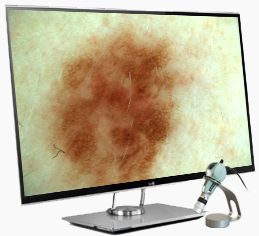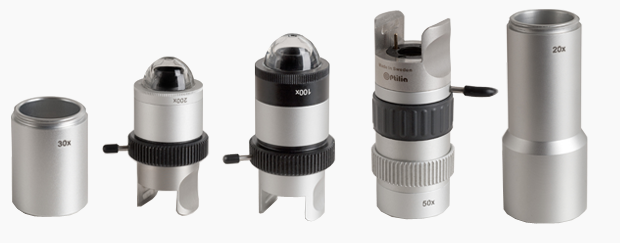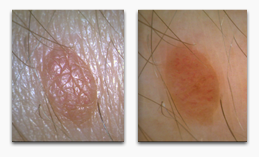
Knowledge
The Optilia Dermatoscoscopy system has been designed and developed with a practical size in mind; to make it flexible and light enabling the device to be used on all skin locations the whole day.
A video dermatoscope system provides a very flexible solution compared to a standard dermatoscope. The explanation to this is that the physician doesn't need to examine the mole through the dermatoscope, instead will studying the image on a monitor. This gives an ergonomic way of positioning the device but it also implies an improved integrity between patient and physician in some cases.

Monitor imaging a mole |
By using a video dermatoscope the moles will be imaged on a monitor, which allows both the physician as well as the patient to study the dermascope image. This will improve the communication and interaction between them and a superior understanding of suspicious moles is achievable by the patient. |
With a video dermatoscope all of the images can be saved and document directly to a computer. The Optilia systems provides a convenient way of taking images by triggering a button on the device or by using a foot switch, the images are automatically saved onto the PC in a database. Stored images can be used for following up and to verify if and changes have occurred.
|
To remove light reflection from the skin most hand held dermatoscope uses a liquid interface such as immersion oil. It is also possible to use an optical filter, called polarizer, to filter out the reflection. How it works is to pass light of specific orientation and blocks other polarization types. Optilia's varifocal lens includes an adjustable polarizer which is included in all of Optilia's dermatoscopy system and no liquid is needed. By changing the polarizer it is possible to choose the amount of reflected light, with reflection it is possible to highlight the skin texture. |
|
A varifocal lens is a camera lens with changeable focal length which allows the user to vary the working distance and also the magnification with the same lens. Optila's varifocal lens can be used together with three fixed magnification adapters; 20x, 30x and 50x which can easily be exchanged between. The benefit of using fixed magnifications is that they are pre-calibrated which enables measurements to directly be made on the image as soon as it is stored.
The dermatoscope was design to easily change lenses in addition to the varifocal lens the dermatoscope can also use Optilia's 100x and even with 200x lens. This means that the dermatoscope also could be used for other applications such as capillaroscopy.
 Range of lenses with different magnifications, 20x
up to 200x, compatible with the dermatoscope
Range of lenses with different magnifications, 20x
up to 200x, compatible with the dermatoscope
The Optilia's dermatoscopy lens uses manual focus which in practice is set once since it is used on the same working distance (skin is flat). The advantage of using a manual focus compared to an automatic is that it is quicker; the system doesn't need to wait for the system to refocus. The manual focus for Optilia's lens is also lockable which a convenient way to prevent accidentally changing focus is.
Correct lightning is important when examining different type of skins. To make sure that correct lightning is used for all of the skin types the Optilia's video dermatoscope has adjustable illumination, controlling LED intensity.
Optilia's Dermatoscope can be used with most PC which means that it is possible for the physician to integrate the dermatoscope to the currently used system, and no need to use separate systems.Read more...

 Dermascopic images of
same mole, non-polarised to left, polarised to right
Dermascopic images of
same mole, non-polarised to left, polarised to right

